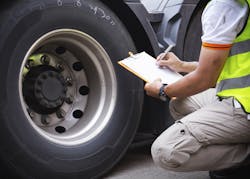When irregular tire wear talks, fleets need to listen
Every tire guy like me loves it when tread is worn evenly to 4/32nd or 2/32nd, depending on the position and application. A perfectly worn steer, drive, or trailer tire is a thing of beauty and a sign that several factors came together as they should. The tire manufacturer plays an obvious role but so do the drivers, maintenance technicians, and tire service technicians who contributed in every 32nd of smooth and even treadwear.
On the other hand, when tires are not worn evenly and are removed from service early because there are random spots in major grooves where the tread depth is below the legal limits, someone must answer for the lost mileage from that rubber. It typically starts with the company that sold the tire—and then it flows all downhill from there. Mileage is money in the truck tire business, so lost mileage means more money spent on tires for a fleet. It’s got to be someone’s fault.
See also: Fleets move outside traditional channels to find parts
Playing the blame game does not guarantee the problem will be solved. In most cases, irregular wear is trying to tell the operator something. Usually there’s a reason why the tire is not wearing evenly, and during times where limited availability is combining with rising prices, getting a price concession should not be the goal. Fleets need to listen to irregular treadwear and take necessary steps to prevent it because tires are only going to get more expensive and harder to find.
The first place to check is inflation pressure, which must be checked with a reliable air gauge any time the treadwear doesn’t “look right.” Insufficient pressure for the load is an obvious problem because it leads to excessive heat and eventual failure, but overinflation also could be a cause. Severe wear patterns don’t happen overnight; they start subtle and just get worse with every mile. If a driver or maintenance technician notices an irregular treadwear pattern starting and checks the inflation pressure of the tire and its dual or steer mate before reporting the problem, it’s a great start toward getting the most mileage out of that and every tire.
See also: 7 actions to manage maintenance and repair cost increases
Like the inflation pressure, you can’t just check the tread depth on one tire. At a minimum, they should be checked across the axle in steer, drive, and trailer positions. Ideally, all the tread depths are recorded in each of the major grooves. Truck tires in a dual position have a maximum difference in diameter of half an inch, which translates to a 4/32nd-inch tread depth for identical tires. Dimensions are nominal, so the 4/32nd guideline is not always accurate when different makes and models operate in the same dual position, but any dual tire with more than 4/32nd of an inch difference in tread depth should be checked for diameter. A lot of trailer tires get removed early because of mismatched diameters.
If the inflation pressures and tread depth measurements are within specifications, the next step is to check the seating on the rim. There are molded ribs on the lower sidewall of every tire that can be used to identify a tire that is not concentrically seated. If the distance between the edge of the rim and the molded ribs varies, the tire was not properly mounted. This is especially an issue for steer tires. Non-concentrically seated steer tires can develop severe wear conditions in a short amount of time.
If the air pressure, tread depth, and seating have been ruled out, then it’s time to contact the vendor and/or manufacturer directly because the next steps will require extra effort and expertise. Improper alignment, excessive run-out, and worn suspension components all can cause irregular treadwear. With the low hanging fruit of pressure, tread depth, and seating out of the picture, there must be a reason why the tire is not wearing evenly.
If fleets take the time to look at the treadwear and listen to what it’s saying, most problems can be solved before it’s too late and the tire must be replaced early.
About the Author
Kevin Rohlwing
Kevin Rohlwing is the SVP of training for the Tire Industry Association. He has more than 40 years of experience in the tire industry and has created programs to help train more than 180,000 technicians.

